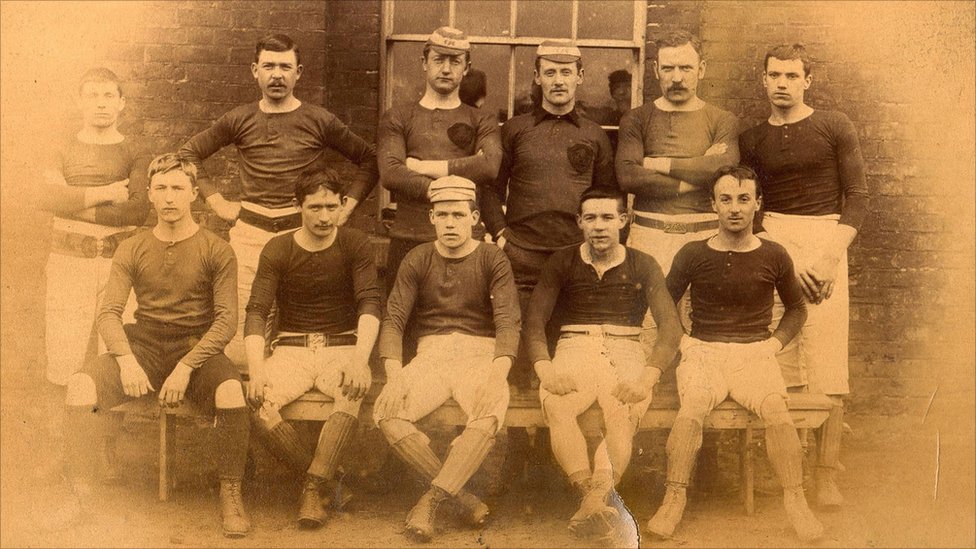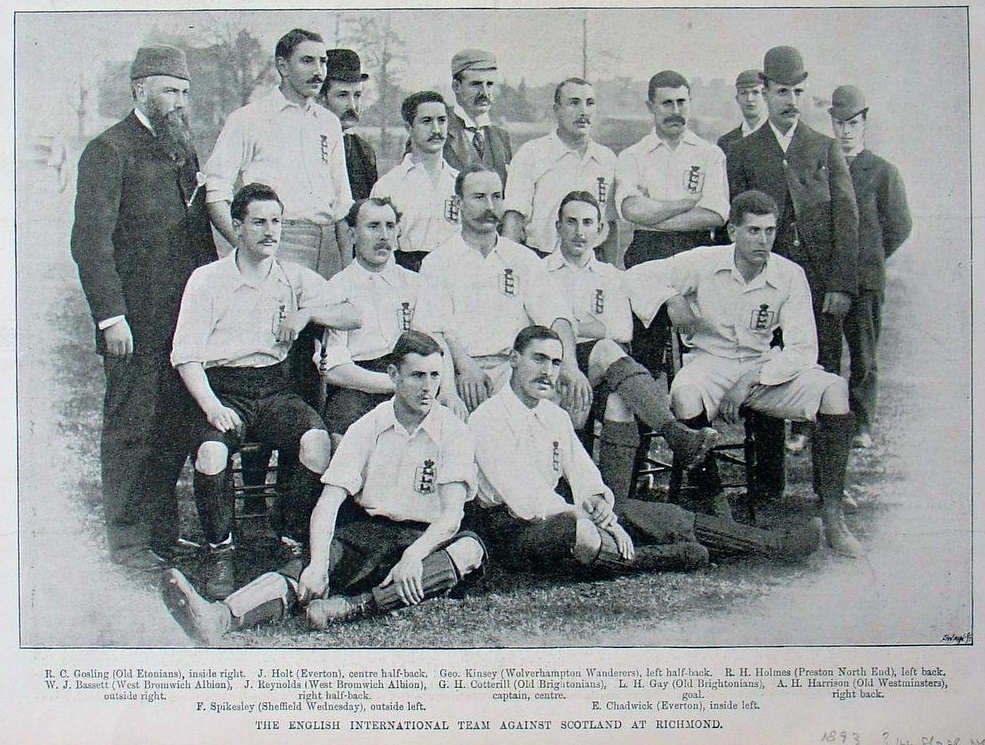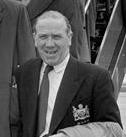|
William Evans (footballer)
William Addams Williams Evans (September 1853 – 23 April 1919) was a Welsh churchman who played for the Wales national football team, in the first two international matches in 1876 and 1877 before a long career as a Church of England minister. Early life and education Evans was born in Usk, Monmouthshire, the son of the local vicar and the grandson of William Addams Williams of Llangibby Castle, the County Magistrate for Monmouthshire, after whom he was named. After completing his education at Shrewsbury School, Evans went up to St John's College, Oxford in 1872. Evans graduated in 1877 as a Bachelor of Arts and was then ordained as a Church of England curate. Church career Evans served as a curate at Barwell in Leicestershire for six years before brief periods at All Saints, Northampton and his last English parish at Harrowden, Bedfordshire. In 1885, he returned to Monmouthshire becoming rector of Llandegveth in 1886, where he remained until his death in 1919. Foot ... [...More Info...] [...Related Items...] OR: [Wikipedia] [Google] [Baidu] |
Wales National Football Team
) , Association = Football Association of Wales (FAW) , Confederation = UEFA (Europe) , Coach = Rob Page , Captain = Gareth Bale , Most caps = Gareth Bale (111) , Top scorer = Gareth Bale ( 41) , Home Stadium = Cardiff City Stadium , FIFA Trigramme = WAL , FIFA Rank = , FIFA max = 8 , FIFA max date = October 2015 , FIFA min = 117 , FIFA min date = August 2011 , Elo Rank = , Elo max = 3 , Elo max date = 1876~1885 , Elo min = 88 , Elo min date = March 2011 , pattern_la1 = _wal22h , pattern_b1 = _wal22h , pattern_ra1 = _wal22h , pattern_sh1 = _wal22h , pattern_so1 = _3_stripes_white , leftarm1 = FF0000 , body1 = FF0000 , rightarm1 = FF0000 , shorts1 = FFFFFF , socks1 = FF0000 , pattern_la2 = _wal22a , ... [...More Info...] [...Related Items...] OR: [Wikipedia] [Google] [Baidu] |
Oxford University
Oxford () is a city in England. It is the county town and only city of Oxfordshire. In 2020, its population was estimated at 151,584. It is north-west of London, south-east of Birmingham and north-east of Bristol. The city is home to the University of Oxford, the oldest university in the English-speaking world; it has buildings in every style of English architecture since late Anglo-Saxon. Oxford's industries include motor manufacturing, education, publishing, information technology and science. History The history of Oxford in England dates back to its original settlement in the Saxon period. Originally of strategic significance due to its controlling location on the upper reaches of the River Thames at its junction with the River Cherwell, the town grew in national importance during the early Norman period, and in the late 12th century became home to the fledgling University of Oxford. The city was besieged during The Anarchy in 1142. The university rose to ... [...More Info...] [...Related Items...] OR: [Wikipedia] [Google] [Baidu] |
Partick
Partick ( sco, Pairtick, Scottish Gaelic: ''Partaig'') is an area of Glasgow on the north bank of the River Clyde, just across from Govan. To the west lies Whiteinch, to the east Yorkhill and Kelvingrove Park (across the River Kelvin), and to the north Broomhill, Hyndland, Dowanhill, Hillhead, areas which form part of the West End of Glasgow. Partick was a Police burgh from 1852 until 1912 when it was incorporated into the city.Second City of The Empire: 1830s to 1914 from theglasgowstory.com. Retrieved 22 December 2011. Partick is the area of the city most connected with the Highlands, and several Gaelic agencies, such as the Gaelic Books Council ( |
Hamilton Crescent
Hamilton Crescent is a cricket ground in the Partick area of Glasgow, Scotland, which is the home of the West of Scotland Cricket Club. Hamilton Crescent hosted the 1872 Scotland v England football match, first international football match, between Scotland national football team, Scotland and England national football team, England, played on 30 November 1872, which ended in a goalless draw, and was watched by a crowd of 4,000. A plaque on the wall of the clubhouse was placed to commemorate the match in 2002 by Mr John C McGinn, President of the Scottish Football Association. Further international matches were held here in 1874 and 1876, before being moved to the Hampden Park (1873–83), first Hampden Park. The 1877 Scottish Cup Final was also held at Hamilton Crescent, as was a rugby union international when Scotland national rugby union team, Scotland and Wales national rugby union team, Wales drew their match in the 1885 Home Nations Championship. [...More Info...] [...Related Items...] OR: [Wikipedia] [Google] [Baidu] |
England National Football Team
The England national football team has represented England in international football since the first international match in 1872. It is controlled by The Football Association (FA), the governing body for football in England, which is affiliated with UEFA and comes under the global jurisdiction of world football's governing body FIFA. England competes in the three major international tournaments contested by European nations: the FIFA World Cup, the UEFA European Championship, and the UEFA Nations League. England is the joint oldest national team in football having played in the world's first international football match in 1872, against Scotland. England's home ground is Wembley Stadium, London, and its training headquarters is St George's Park, Burton upon Trent. The team's manager is Gareth Southgate. England won the 1966 World Cup Final (a tournament it also hosted), making it one of eight nations to have won the World Cup. They have qualified for the World Cup 16 times ... [...More Info...] [...Related Items...] OR: [Wikipedia] [Google] [Baidu] |
Shrewsbury
Shrewsbury ( , also ) is a market town, civil parish, and the county town of Shropshire, England, on the River Severn, north-west of London; at the 2021 census, it had a population of 76,782. The town's name can be pronounced as either 'Shrowsbury' or 'Shroosbury', the correct pronunciation being a matter of longstanding debate. The town centre has a largely unspoilt medieval street plan and over 660 listed buildings, including several examples of timber framing from the 15th and 16th centuries. Shrewsbury Castle, a red sandstone fortification, and Shrewsbury Abbey, a former Benedictine monastery, were founded in 1074 and 1083 respectively by the Norman Earl of Shrewsbury, Roger de Montgomery. The town is the birthplace of Charles Darwin and is where he spent 27 years of his life. east of the Welsh border, Shrewsbury serves as the commercial centre for Shropshire and mid-Wales, with a retail output of over £299 million per year and light industry and distribution c ... [...More Info...] [...Related Items...] OR: [Wikipedia] [Google] [Baidu] |
John Hawley Edwards
John Hawley Edwards (21 March 1850 – 14 January 1893) was an English footballer who made one appearance for England in 1874, before going on to play for Wales in 1876. He was a member of the Wanderers team that won the 1876 FA Cup Final. Career Edwards was born in Shrewsbury, educated at Shifnal Grammar School, and was a qualified solicitor, being admitted in 1871. He played from 1873 to 1880 for Shropshire Wanderers, of which he was a founder and captain, when they reached the semi-final tie of the FA Cup in 1874–75 and were defeated by the Old Etonians. He was called into the England side as a late replacement for another Shrewsbury-born player, John Wylie. He made his solitary England appearance on 7 March 1874 against Scotland, playing as an inside forward. After "a most competitive game", Scotland won 2–1, with Robert Kingsford scoring England's consolation goal. He was also a member of the Wanderers team, making his first appearance on 4 March 1874, scori ... [...More Info...] [...Related Items...] OR: [Wikipedia] [Google] [Baidu] |
North Wales
North Wales ( cy, Gogledd Cymru) is a region of Wales, encompassing its northernmost areas. It borders Mid Wales to the south, England to the east, and the Irish Sea to the north and west. The area is highly mountainous and rural, with Snowdonia National Park ( and the Clwydian Range and Dee Valley (), known for its mountains, waterfalls and trails, wholly within the region. Its population is concentrated in the north-east and northern coastal areas, with significant Welsh-speaking populations in its western and rural areas. North Wales is imprecisely defined, lacking any exact definition or administrative structure. It is commonly defined administratively as its six most northern principal areas, but other definitions exist, with Montgomeryshire historically considered to be part of the region. Those from North Wales are sometimes referred to as "Gogs" (from "Gogledd" – the Welsh word for "north"); in comparison, those from South Wales are sometimes called "Hwntws" by those fr ... [...More Info...] [...Related Items...] OR: [Wikipedia] [Google] [Baidu] |
1876 Scotland V Wales Football Match
The 1876 association football match between the national teams representing Scotland and Wales was the first game played by the latter side. It took place on 25 March 1876 at Hamilton Crescent, Partick, the home ground of the West of Scotland Cricket Club. The match was also the first time that Scotland had played against a side other than England. The fixture was organised by Llewelyn Kenrick, who had founded the Football Association of Wales (FAW) only a few weeks earlier in response to a letter published in '' The Field''. Advertisements were placed in several sporting journals for Welsh players, or those with more than three years residence in the country, to come forward and the Welsh team was selected after trial matches were held at the Racecourse Ground in Wrexham. The FAW selected the side and Kenrick was appointed captain for the fixture. As the more experienced team, Scotland dominated the match and had several chances to score in the first half. They had a goal dis ... [...More Info...] [...Related Items...] OR: [Wikipedia] [Google] [Baidu] |
South Wales
South Wales ( cy, De Cymru) is a loosely defined region of Wales bordered by England to the east and mid Wales to the north. Generally considered to include the historic counties of Glamorgan and Monmouthshire, south Wales extends westwards to include Carmarthenshire and Pembrokeshire. In the western extent, from Swansea westwards, local people would probably recognise that they lived in both south Wales and west Wales. The Brecon Beacons National Park covers about a third of south Wales, containing Pen y Fan, the highest British mountain south of Cadair Idris in Snowdonia. A point of some discussion is whether the first element of the name should be capitalised: 'south Wales' or 'South Wales'. As the name is a geographical expression rather than a specific area with well-defined borders, style guides such as those of the BBC and ''The Guardian'' use the form 'south Wales'. In a more authoritative style guide, the Welsh Government, in their international gateway website ... [...More Info...] [...Related Items...] OR: [Wikipedia] [Google] [Baidu] |
Scotland National Football Team
The Scotland national football team gd, Sgioba Ball-coise Nàiseanta na h-Alba sco, Scotland National Fitbaa Team represents Scotland in men's international football and is controlled by the Scottish Football Association. It competes in the three major professional tournaments: the FIFA World Cup, UEFA Nations League and the UEFA European Championship. Scotland, as a country of the United Kingdom, is not a member of the International Olympic Committee, and therefore the national team does not compete in the Olympic Games. The majority of Scotland's home matches are played at the national stadium, Hampden Park. Scotland is the joint oldest national football team in the world, alongside England, whom they played in the world's first international football match in 1872. Scotland has a long-standing rivalry with England, whom they played annually from 1872 until 1989. The teams have met only eight times since then, most recently in a group match during Euro 2020 in June 2021. ... [...More Info...] [...Related Items...] OR: [Wikipedia] [Google] [Baidu] |
The Field (magazine)
''The Field'' is a British monthly magazine about country matters and field sports. It was started as a weekly magazine in 1853, and has remained in print since then; Robert Smith Surtees was among the founders. In the nineteenth century it was known as ''Field: The Country Gentleman's Newspaper''. The magazine is one of the earliest hobby magazines. It is published by TI Media, subsidiary of Future plc. Editors of ''The Field'' * 1853–1857 Mark Lemon * 1857–1888 John Henry Walsh * 1888–1899 Frederick Toms * 1900–1910 William Senior * 1910–1928 Sir Theodore Andrea Cook Sir Theodore Andrea Cook (28 March 1867 – 16 September 1928) was a British art critic and writer. Sporting activities Theodore Cook spent his early years in Wantage after his father, Henry Cook, became the headmaster of King Alfred's Scho ... * 1931–1937 Eric Parker * 1938–1946 Brian Vesey-Fitzgerald * 1947–1950 Leonard V Dodds * 1951–1977 Wilson Stephens * 1977–1984 Derek Bingham ... [...More Info...] [...Related Items...] OR: [Wikipedia] [Google] [Baidu] |


.jpg)


